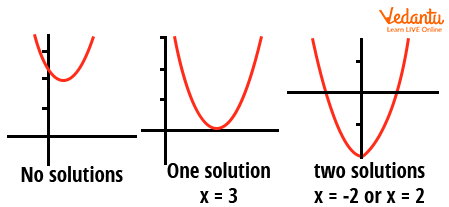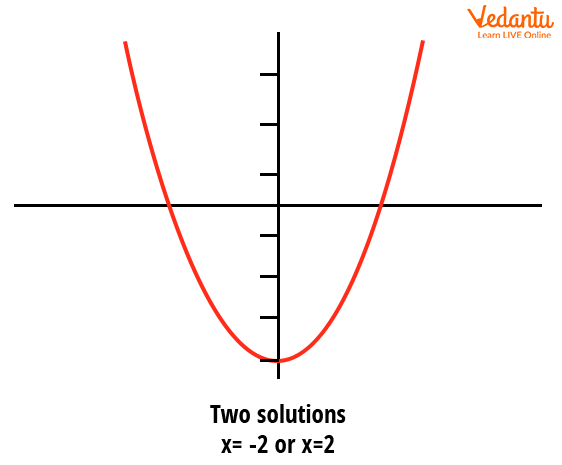




Methods to Solve Quadratic Equations Easily
A quadratic equation is any equation expressible in the standard form $ax^2 + bx + c = 0$ with $a \neq 0$, where $a, b, c \in \mathbb{C}$. The values of $x$ that solve this equation are termed its roots.
Algebraic Structure and Definition of Roots for Quadratic Equations
Given $ax^2 + bx + c = 0$ ($a \neq 0$), the roots of the quadratic equation are values $\alpha, \beta \in \mathbb{C}$ such that $a\alpha^2 + b\alpha + c = 0$ and $a\beta^2 + b\beta + c = 0$.
The standard form can always be factorised (possibly over $\mathbb{C}$) as $a(x - \alpha)(x - \beta) = 0$, with both roots accounted for, potentially repeated or complex.
Derivation and Use of the Quadratic Formula
Consider $ax^2 + bx + c = 0$. Dividing through by $a$ (possible since $a \neq 0$) yields $x^2 + \frac{b}{a}x + \frac{c}{a} = 0$.
Completing the square, add and subtract $\left(\frac{b}{2a}\right)^2$ to obtain:
$x^2 + \frac{b}{a}x + \frac{b^2}{4a^2} = -\frac{c}{a} + \frac{b^2}{4a^2}$
$\left(x + \frac{b}{2a}\right)^2 = \frac{b^2 - 4ac}{4a^2}$
Taking the square root, $x + \frac{b}{2a} = \pm \frac{\sqrt{b^2 - 4ac}}{2a}$, which gives the explicit root formula:
Result: The roots are given by $x = \frac{-b \pm \sqrt{b^2 - 4ac}}{2a}$, where $b^2 - 4ac$ is termed the discriminant.
Analysis of Root Nature via the Discriminant
Let $D = b^2 - 4ac$ be the discriminant of the quadratic equation.
- Real and unequal roots if $D > 0$
- Real and equal roots if $D = 0$
- Complex conjugate roots if $D < 0$
For $D = 0$, both roots coalesce as $x = -\frac{b}{2a}$; for $D < 0$, the two roots are complex conjugates with real part $-\frac{b}{2a}$.

Sum and Product of Roots for Quadratic Equations
Let $\alpha$ and $\beta$ denote the roots. By direct computation:
$\alpha + \beta = \dfrac{-b}{a}$;
$\alpha \beta = \dfrac{c}{a}$.
These expressions follow from Vieta’s relations and are valid over $\mathbb{C}$ regardless of nature of roots.
A quadratic equation may always be reconstructed as $a(x^2 - (\alpha+\beta)x + \alpha\beta) = 0$ given its roots.
Primary Solution Methods for Quadratic Roots
The solution techniques for finding the roots of quadratic equations are as follows:
- Direct factorization (if factorable in the relevant domain)
- Quadratic formula (always applicable)
- Completing the square (converts to formula algebraically)
- Graphical identification (real roots via x-intercepts of the parabola)
Graphical methods are limited to real roots, while algebraic methods identify all root types.
Illustrative Solution Techniques Applied to Diverse Quadratic Equations
Example: Determine the roots of $x^2 - 7x + 10 = 0$ using all principal approaches.
(a) Factorization Method:
$x^2 - 7x + 10 = (x - 2)(x - 5) = 0$; roots are $x = 2, 5$.
(b) Quadratic Formula:
$a = 1, b = -7, c = 10$
$x = \frac{7 \pm \sqrt{(-7)^2 - 4 \times 1 \times 10}}{2}$
$= \frac{7 \pm \sqrt{9}}{2}$
$= \frac{7 \pm 3}{2} \implies x = 5, 2$
(c) Completing the Square:
$x^2 - 7x + 10 = 0$
$x^2 - 7x = -10$
$x^2 - 7x + \frac{49}{4} = -10 + \frac{49}{4}$
$(x - \frac{7}{2})^2 = \frac{9}{4}$
$x - \frac{7}{2} = \pm \frac{3}{2}$
$x = 5, 2$
Quadratic Equations Roots In Detail includes further extensions with irrational and complex examples.
Constraint-Driven Examples on Quadratic Roots
Example: Find all $k \in \mathbb{R}$ for which $3x^2 + kx + 2 = 0$ has coincident roots.
Equal roots $\Longleftrightarrow$ discriminant zero: $k^2 - 24 = 0 \implies k = \pm 2\sqrt{6}$.
Example: If $(p+1)x^2 - 2px + (q+1) = 0$ has roots $\alpha, \beta$, then $\alpha + \beta = \frac{2p}{p+1}$ and $\alpha\beta = \frac{q+1}{p+1}$.
Geometric Characterization of Quadratic Equation Roots
The graph of $y = ax^2 + bx + c$ is a parabola. Its intersection with the $x$-axis corresponds to real roots. Exam Tip: If the parabola is tangent to the $x$-axis, the roots coincide.

For further systematic exploration refer to Quadratic Equations Overview or study Quadratic Inequalities Explained for root-based inequality analysis.
Typical Errors Regarding Quadratic Roots
- Assuming all quadratics have real roots
- Incorrectly applying formula when $a = 0$
- Omitting check of discriminant for root nature
- Loss of sign in sum and product expressions
- Mistaking multiplicity for distinctness
Practice varied forms through Problems on Quadratic Equations and extend to optimization with Maxima and Minima of Quadratics.
FAQs on How to Find the Roots of a Quadratic Equation
1. What are the methods to find the roots of a quadratic equation?
There are three main methods to find the roots of a quadratic equation: factorization, completing the square, and using the quadratic formula.
- Factorization: Express the equation in the form ax2 + bx + c = 0 and factorise it into two linear terms.
- Completing the Square: Rearrange the equation to create a perfect square trinomial.
- Quadratic Formula: Use the formula x = [-b ± √(b2 - 4ac)] / (2a) for any quadratic equation ax2 + bx + c = 0.
2. What is a quadratic equation and how is it defined?
A quadratic equation is a polynomial equation of degree two, generally written as ax2 + bx + c = 0, where a ≠ 0.
- The variable 'x' is unknown.
- 'a', 'b', and 'c' are constants, with 'a' not equal to zero.
- Such equations have at most two real roots.
3. What is the quadratic formula and when is it used?
The quadratic formula is used to find the roots of any quadratic equation and is especially useful when factorization is difficult.
The formula is:
- x = [-b ± √(b2 - 4ac)] / (2a)
- 'a', 'b', and 'c' are coefficients from ax2 + bx + c = 0.
- The expression under the square root, b2 - 4ac, is called the discriminant.
4. What are the types of roots possible for a quadratic equation?
The nature of roots of a quadratic equation depends on the discriminant (D = b2 - 4ac):
- Two distinct real roots if D > 0
- Two equal real roots if D = 0
- Two complex roots if D < 0
5. How do you determine the discriminant of a quadratic equation?
The discriminant of a quadratic equation ax2 + bx + c = 0 is calculated as D = b2 - 4ac.
- If D > 0: Roots are real and unequal.
- If D = 0: Roots are real and equal.
- If D < 0: Roots are complex and conjugate.
6. Can every quadratic equation be solved by factorization?
No, not every quadratic equation can be solved by factorization, especially if its roots are irrational or complex.
- Factorization is used when roots are rational numbers.
- If the equation cannot be easily factorized, the quadratic formula or completing the square methods are used.
7. What is meant by the roots of a quadratic equation?
The roots of a quadratic equation are the values of 'x' that satisfy the equation ax2 + bx + c = 0.
- They are also called zeroes or solutions of the equation.
- Each quadratic equation has at most two roots.
8. Why is it important to find the roots of a quadratic equation?
Finding the roots of a quadratic equation helps solve real-life problems involving motion, area, finance, and geometry.
- They are essential in algebra, coordinate geometry, and higher mathematics.
- They help in analyzing the parabola graph and its intersections with the x-axis.
9. How can you verify the roots of a quadratic equation?
To verify the roots of a quadratic equation, substitute the found values of 'x' back into the original equation and check if the equation equals zero.
- If ax2 + bx + c = 0 is satisfied for both values, the roots are correct.
- This process confirms the accuracy of your solution.
10. What are some real-life applications of quadratic equations?
Quadratic equations appear in many real-life scenarios involving area, projectile motion, and business optimization problems.
- Calculating maximum height in physics problems.
- Determining profit and loss in business.
- Finding area or dimensions in geometry.
























